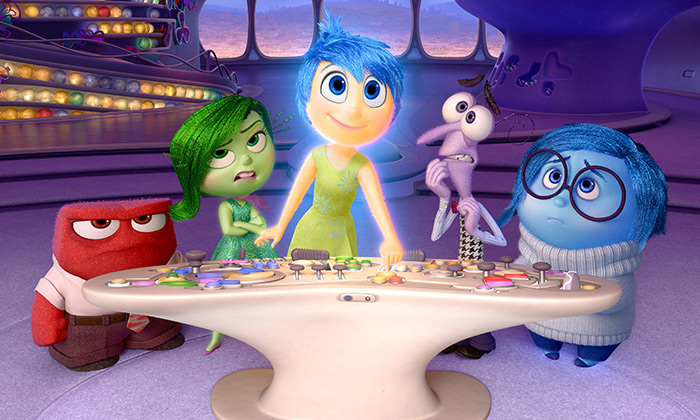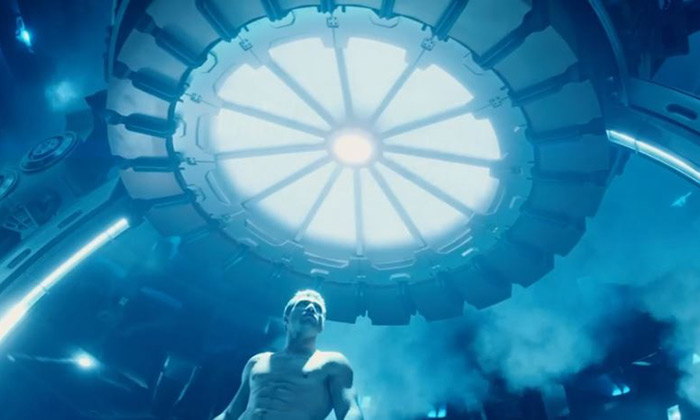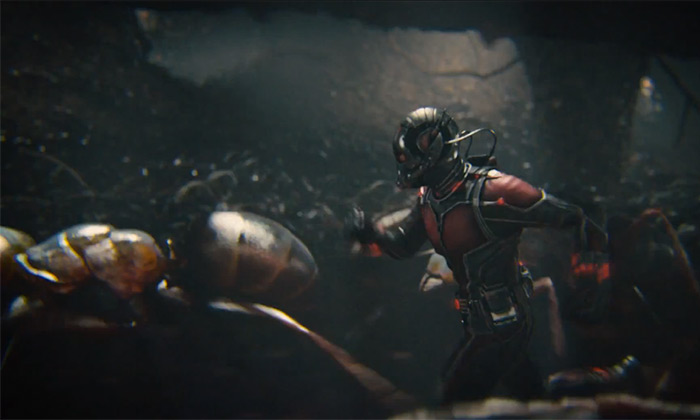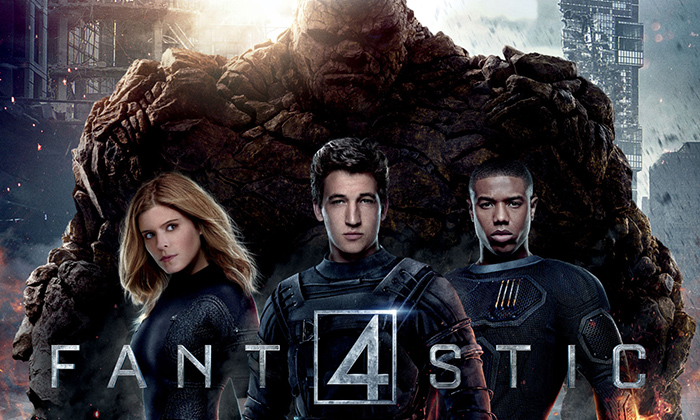With summer movie season in full swing, cinema-goers are leaving theaters with one big question in mind: “Wait, could that really happen?”
Many science experts have answered (“Well, no”) for movies like Jurassic World. Still, we found inspiration in Jackson School of Geosciences paleontologist Matthew Brown’s take. Writing in PLOS blogs, Brown said: “It should be no surprise that scientists with advanced degrees in a field know more than producers, directors, writers, and other members of the general public; but instead of fact-checking them at every turn, let’s walk that public through the same joy of discovery that we experience every day.”
So we assembled a crack team of scientists to walk us through that joy — while also rating the sometimes far-fetched notions in these upcoming films. It's the Science Truth Detector.
Inside Out

Plot summary: After a young girl is uprooted from her Midwestern life and moves to San Francisco, her emotions conflict on how best to navigate a new city, house and school.
Hypothesis: At least three scientific suggestions play a role in the film:
1) The things we say and do are governed by five emotions: Joy, Anger, Disgust, Fear and Sadness.
"These five 'core emotions' are shared across human cultures and play a major role in our thoughts and actions," says Alison Preston, associate professor of neuroscience and psychology.
The film's producers did leave out one core emotion: surprise. And our actions can definitely be swayed by other emotions such as pride, envy and embarrassment. Still, the film gets this mostly right.
2) When you reflect on memories of past events, your current emotions can alter those memories.
Scientists have shown that existing (non-emotional) memories could be retroactively enhanced by a later emotional experience that related to them, suggesting this idea is right-on.
"Memories are not stable records," says Preston. "We constantly reevaluate and reconstruct our experiences."
3) Your brain has distinct regions for long-term memory and imagination, as well as a control room where your emotions argue about what you should do or say.
"Many tasks that require imagination use the same brain regions that are used in long-term memory," says Preston. "The brain does have a control room of sorts in the prefrontal cortex that controls other brain regions involved in memory, imagination, emotion, thinking and perception.” She adds that the brain is highly interconnected and no one brain region is linked to only one function. “It is a massively parallel processor."
Overall science truth detector rating: Smart brain science
Terminator: Genisys

Plot summary: In the future, humans and robots are battling for control over the world. Both humans and robots travel back in time to try and alter the course of history to assure their own victory.
Hypothesis: Time travel is possible, and if you traveled back in time, you could alter the course of history to the point of erasing yourself or others from ever being born.
There are two ways you might conceivably travel back in time, says Jacques Distler, professor of physics. One involves traveling faster than the speed of light. Unfortunately for time-travel enthusiasts, the theory of relativity says it's impossible to travel faster than light — and relativity has held up to a century's worth of experiments.
The other proposal takes advantage of a key insight of relativity theory, which is that matter warps space and time. So perhaps there are places in the universe (or you could create one) where time loops back in on itself.
"You could travel through this loop and end up in the same place but at an earlier time," says Distler. "When people try to cook up these 'closed time-like curves,' they find that they are either hidden behind the horizon of a black hole, or, as a result of Steven Hawking's research, require unphysical negative energy densities for their existence."
So traveling back in time would require some entirely new kind of physics that's hard for even the professionals to imagine.
But let's say you don't believe the experts, what can our own experiences tell us about the possibility of time travel? As Steven Hawking observed, there seems to be strong evidence that time travel is not possible because "we have not been invaded by hordes of tourists from the future."
If it were actually possible to go back in time, says Distler, it would turn the whole notion of cause and effect on its head. "Usually causes precede their effects, but now you're allowing things to loop back in time, and the effect precedes the cause," he says. "Mother Nature abhors messing up cause and effect." Since physics relies on the ability to start with an understanding of how things are now and predict what they will be like in the future, throwing out cause and effect would make it impossible to have a coherent theory of physics.
(Not a main idea of the film but also worth noting: A quirk of time travel as described in the Terminator series is that when you arrive at your destination, your clothes don't arrive with you, to which Distler responds: "Why you can only travel back in time naked is a bit beyond me.”)
Overall science truth detector rating: Flaky physics
Trainwreck

Plot summary: From a very young age, Amy has been taught that monogamy isn’t realistic. But falling for the subject of a magazine article she's writing puts her worldview to the test.
Hypothesis: Humans have the ability to be truly monogamous.
Animal behaviorists who study nonhuman animals have a pretty loose definition of monogamy: males pair up with a mate, defend the pair's territory and help raise their young. Under that definition, a bird that cheats on its mate by having "extra pair copulations" is still considered monogamous. "We define it that way because very few species would fit a more anthropomorphic definition of monogamy," says Rebecca Young Brim, a research fellow focused on animal behavior.
We humans are much more complex. For one thing, according to Paul Eastwick, assistant professor of human development and family sciences, we form psychological attachments to partners that run much deeper than those of other animals. That allows us as individuals to stay together with the same person for much of our lives, makes us feel rotten when we're apart and enables us — even when we find other people attractive — to control our urges to cheat. In Eastwick's view, a human definition of monogamy should include this deep psychological attachment.
But what about cheating? A partner who cheats might still be considered monogamous, but cheating often goes hand-in-hand with a weakening of the psychological attachment between the primary partners, perhaps followed by the end of the previously monogamous relationship.
"So yes, humans can be monogamous," says Eastwick. "But people will still find themselves sexually attracted to other people. We have defense mechanisms, but they aren't perfect."
Overall science truth detector rating: Solid science on solid relationships
Ant-Man

Plot summary: Through a high-tech Ant-Man suit, conman Scott Lang has the ability to shrink in scale but get stronger. With his extraordinary powers, he is called on to save the world.
Hypothesis: Ants are incredibly strong and fast.
Leafcutter ants can move loads up to eight times their body weight. That's roughly equivalent to a person carrying a telephone pole. "In my view, the coolest feat of strength ants do is group-carrying prey items," says Edward LeBrun, a research associate focusing on ants. "This is when many ants coordinate to carry a very large prey item. I have watched groups of 50-plus workers carry whole grasshoppers off at about six and a half feet per minute."
Trap jaw ants combine both strength and speed to do aerial flips that would make a ninja jealous. These ants can close their mandibles at 200 feet per second generating an instantaneous force equivalent to up to 500 times their body mass. "They point their mandibles at the ground or a nearby object and fire them," says LeBrun. "The resulting recoil throws them through the air. They can propel themselves up to eight inches or about 40 body lengths. This is roughly equivalent to a person being able to punch a wall and be thrown backwards 200 feet." (This video shows the Evel Knievel of trap jaw ants. Find more eye-popping ant videos here.)
Overall science truth detector rating: Strong insect science
Fantastic Four

Plot summary: Four young outsiders teleport to an alternate universe and return home with superhuman abilities.
Hypotheses: Our universe is just one of many universes. And it's possible for humans to travel between them.
"Unfortunately, it's hard to tell what they're really talking about in the trailer for this film," says Jacques Distler, professor of physics. "But, as someone whose day job involves thinking about string theory, we do talk about the possibility of multiple universes." According to some versions of the theory, universes can spontaneously appear like bubbles within other universes and then grow rapidly. From the perspective of someone inside one of these bubbles, it looks just like an expanding universe. He or she can't tell that there's an outside.
A God's eye view of this multiverse would look something like Swiss cheese, with each bubble being a whole universe of its own (though you have to keep in mind that both the bubbles and the surrounding cheese are expanding exponentially). "But for now this is all highly speculative," says Distler. "We really don't know if these universes exist."
Let's say they do exist, though, could we travel between them? The short answer, says Distler, is no. We might, however, encounter one. When one of those bubbles forms, it expands at the speed of light. Anything the bubble wall encountered in its path would be destroyed. So if the rest of the story is correct, we might someday meet an untimely end in the form of such a collision. Fortunately, it would happen entirely without warning; since the bubble wall approaches as fast as any signal could reach us, we would never know what hit us.
Overall science truth detector rating: Science hanging by a string
[Ed. note: This review was updated on 7/1/15 to reflect the film's departure from the original Fantastic Four premise in which cosmic rays are responsible for the heroes' superpowers. Thanks to our super readers for catching that.]

















Comments 2
A fun idea. I like it but haven't figured out how to "share" it yet. You need that FaceBook or twitter share button so we can spread the wordbutton
Bill, thanks for the feedback. To share this article, go to the section just below the title and date. You'll see links that say "Comment | Print | Share" If you hover over or right-click on Share, you'll have several different options to share. Hope this helps! - Marc